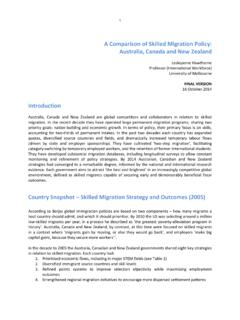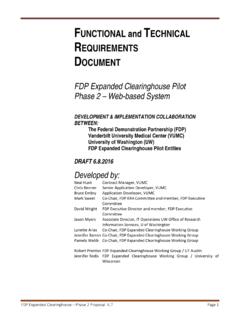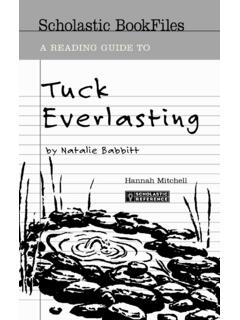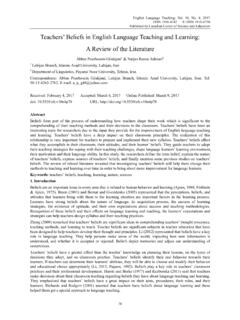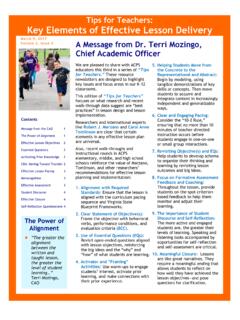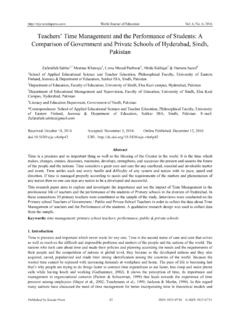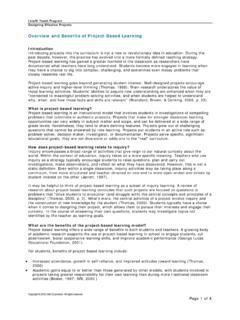Transcription of What types of knowledge do teachers use to engage learners ...
1 Mark Windschitl University of Washington What types of knowledge do teachers use to engage learners in doing science ? _____ Rethinking the continuum of preparation and professional development for secondary science educators A paper commissioned by the National Academy of Sciences High School Science Laboratories: Role and vision. 2004 2 ccomplished musicians and master science teachers have something in common they can both make complex performances look effortless. The great jazz pianist, Thelonious Monk, would take song requests from the audience then reinvent the piece as he played it by changing the key, tempo, and mood of the tune. At the right time he would back off the melody to let another player in his ensemble take charge, then listen for subtle rhythmic cues that it was his turn again to take the lead; his fingers would dance over five octaves on the keyboard while he gazed out at the crowd, smiling.
2 Monk had a deep understanding of the fundamental structure of the music, but knew how to improvise and shape the experience for the audience as well as share the production with others in his band. The experienced science educator is no less an artist. Consider a simple high school laboratory activity that begins with the teacher placing a mass on a scale at the front of the classroom. The scale reads 10 kilograms. He then produces a large bell jar which he places over the entire scale and attaches the jar to a vacuum pump. Can anyone tell me what the scale will read if I pump all the air out? he asks the class. Over the next 20 minutes he orchestrates a flow of discourse with his students that compels them to hypothesize, suggest thought experiments, make reasoned connections, to try out and justify explanations with one other words, to think.
3 He poses questions that probe the mental models his students are beginning with, assessing how elaborate these models are, how generalizable, whether they refer to observations or to theory. During this time the teacher constantly judges whether the discussion is moving the students toward a scientific way of thinking about the phenomena. He must decide who has pieces of the scientific explanation and how to help students put these together for themselves. He is strategically scaffolding the thinking of the students and assessing group progress on a moment-by-moment basis. In addition to all this, he monitors whether students are following the classrooms norms for civil conversation and the degree of involvement, puzzlement, or frustration of individual students.
4 This is a brief but intense performance for this teacher one of hundreds of interactions with students and the materials of science during the course of the school year. From this relatively common slice of classroom life we can see that many types of teacher knowledge are crucial to the success of inquiry-based instruction, especially when the aim is for students to do the intellectual work. More involved forms of laboratory work (student-designed investigations for example) call for an even greater range of teacher skills. Where do teachers develop the knowledge and expertise for this type of instruction? The areas of undergraduate preparation, pre-service teacher education, and in-service professional development seem to be the primary influences, but the knowledge outcomes of these three phases of teacher growth have been under-examined, especially with respect to the articulations between them.
5 To understand better how teachers develop and deploy certain types of knowledge necessary for laboratory work, this paper addresses the following questions: A 3Q1. What kinds of teacher knowledge and skills are required to design and guide students through different forms of laboratory activity? Q2. Do teachers current preparation and professional development provide them with these knowledge and skills? Q3. How should teachers preparation and professional development be changed to foster the knowledge and skills necessary for effective laboratory instruction? Question 1. What kinds of teacher knowledge and skills are required to design and guide students through different forms of laboratory activity? A framework for thinking about laboratory work To understand the types of teacher knowledge used for guiding laboratory work, we must first identify the characteristics and boundaries of this type of instruction.
6 Laboratory work (or practical work) has been described as any teaching and learning activity which involves, at some point, the students observing or manipulating real objects and materials (Millar, 2004, p. 3). In practice, however, laboratory work is becoming harder to identify as a definable genus of practices distinct from other forms of instruction it is no longer a set of prescribed exercises for students that happen in a place and time separate from the rest of science learning. Students now can be involved in the processes of science in a broader range of circumstances. Computer technology, for example, allows new kinds of interactions with tools, data, and simulated environments, and learners can use many of these technologies in settings other than the classroom.
7 Another reason laboratory work is hard to characterize is that much of it is more aptly described as field work in which students conduct studies outdoors rather than in the classroom. Definitions of laboratory work are elusive also because some teachers move seamlessly between lab work and other forms of instruction, often hybridizing these activity structures ( demonstration-based discussions or just-in-time mini-lectures during student inquiries). Despite the ambiguities of definition, if we are to identify different types of teacher knowledge necessary for particular forms of instruction, a reasonable attempt must be made to create a taxonomy of activities that can fall under the general rubric of laboratory work.
8 I describe (in a following section) six different activity structures1 commonly used in classrooms that fall under the general category of laboratory work. The first three will be discussed together because they are all relatively short term in duration, focus on a single or limited set of ideas, are generally teacher -directed, and have known outcomes. This grouping is not meant to suggest that certain types of laboratory activities are more or less effective, or more or less important in the broader picture of science instruction. These six activity structures are: Demonstrations Building skills Discovery learning 4 Problem solving School science inquiry Authentic forms of inquiry Clearly, in any such taxonomy there will be ambiguities, overlap, gaps, and the inevitable baggage of historical terminology.
9 Any framework, however, is defined by the particular purposes it is designed to serve, and this set of activity structures provides a context for thinking about the types of knowledge teachers use to engage learners under a range of circumstances in which real objects and scientific materials are used. A framework for thinking about teacher knowledge We now turn to the second dimension of this framework the types of teacher knowledge necessary to plan and execute these forms of laboratory work. The framework for categorizing teacher knowledge is based on six guidelines: 1) It is grounded in a constructivist approach to teaching and learning. 2) It does not make artificial distinctions between knowledge and skills (knowing and doing are forms of the same intellectual capacity).
10 3) The types of knowledge needed by teachers to plan and execute laboratory work in its different forms are largely inseparable from the types of knowledge needed to conduct effective science teaching in general. 4) It uses only those categories for teacher knowledge that are potentially responsive to development through undergraduate coursework, pre-service preparation, or professional development. 5) These categories do not include unique forms of knowledge for certain populations of learners such as ELL (English Language learners ) or special education students. 6) Any such framework will always under-specify the knowledge , intuitive understandings, reasoning processes, metacognitive strategies, and other intellectual activities of teachers -in-action because of the inevitable layers of thinking that occur in a social/scientific/educational setting and the contingent nature of teacher cognition in response to changing classroom conditions.





